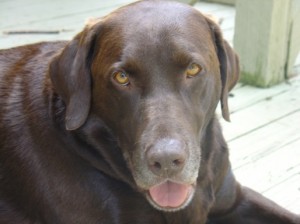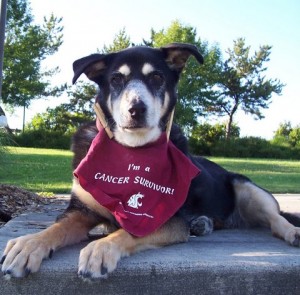So many wonderful people shared their stories with me for this book. What you’ll find below is a showcase of each of these beautiful dogs, several of whom I had the pleasure of meeting in person. I hope that someday, I can meet them all.
| Boomer and Carol | |
 |
Boomer’s first symptom was a cough that would not go away; he was diagnosed with lung cancer at age 11. Because the cancer had metastasized, Carol’s options were limited and she chose to keep Boomer comfortable as long as she could. After several months, where Boomer had lost over 40% of his body weight and stopped eating, Carol took him on one last walk in the park together. Carol chose euthanasia and then cremation. She keeps a lock of his hair and his collar in remembrance. |
| Kess and Tombi | |
| Kess was around 2 when she exhibited signs of lameness in her right hind leg. After rest and a break from competitive flyball competitions, her leg seemed to heal. This pattern continued for several years until a mass was found in her leg, which was removed and a biopsy revealed was not cancerous. However, her leg would not heal properly and after a consultation with another veterinarian, they decided to amputate the leg. A final biopsy showed that Kess did indeed have a rare form of cancer, called synovial cell sarcoma. Eight weeks after the surgery, Kess was able to go back to agility sports and was recently named the number two disc dog in the state of Washington! |  |
| Banner and Barb | |
 |
When Banner was nine years old, his owner, Barb, noticed that his lip was slightly raised, and her veterinarian discovered that several of his front teeth were dying and needed to be removed. An x-ray post-surgery showed a mass, and after further consultations with two veterinary oncologists, they determined that Banner had maxillary fibrosarcoma, a difficult to diagnose cancer due to the fact that it grows in layers. It also does not normally present itself in the front area of the mouth. Surgery is usually the preferred method of treatment for this type of cancer, but would have required that half of Banner’s face be removed due to the location of the tumor. Barb opted for chemotherapy using Palladia and a pamidronate drip therapy to both reduce pain and strengthen the bone. While these treatments worked well initially, over time, the tumor grew larger and more quickly. After more frequent bleeding episodes, difficulties eating and many bad days, the family opted for an in-home euthanasia, and were there with Banner through to the end. |
| Nelson and Jane | |
| Nelson was nine years old when Jane felt a lump on his neck. A biopsy revealed that the tumor was Stage I lymphoma. The veterinary oncologist treated Nelson using the Madison Wisconsin Protocol, a chemotherapy treatment used very successfully in lymphoma cases. Unfortunatley, Nelson had a negative reaction to the treatment, as 10% of dogs do, which required hospitalization and specialized treatment, doubling the cost of treatment. He went into remission in January of 2010 and has never looked back! As part of her approach to Nelson’s care, Jane gathered a team of experts to help her: Western and holistic veterinarians, an oncologist, nutritionist, a physical/aquatic therapist and a pet sitter (also a veterinary technician). She completely modified his diet and added many supplements and Nelson is the healthiest he has ever been! |  |
| Sora and Michelle | |
 |
When Sora was almost ten, a tumor was discovered that was revealed to be insulinoma, a tumor in the pancreas. With limited options at her disposal, Michelle put Sora on prednisone and then learned as much as she could about how to control blood sugar in canine insulinoma patients. Michelle enlisted a team to help her, ranging from family to friends to skilled pet sitters and veterinarians. She developed a recipe for “Sora’s Goo” (see Chapter 5 of the book) which helped her to raise Sora’s blood sugar, but in a more healthy way. Sora passed away at home and was later cremated. The family held a small memorial ceremony later that spring and sprinkled Sora’s ashes in Lake Washington. |
| Lewis and Patty | |
| Lewis was around 12 years old when his veterinarian noticed he was sensitive when his temperature was taken. During the physical portion of the exam, he felt a lump and recommended that a biopsy be taken. The diagnosis was that it was a cancer called anal sac adenocarcinoma. The tumor was removed with surgery and this was followed by a round of chemotherapy. Almost two years later, another small tumor was found, which was also removed and then followed with a chemotherapy round. Earlier this year, Lewis passed away at the ripe age of 14 and a very full life. |  |
| Putter and Carol | |
 |
When Putter was only a few years old, Carol noticed him walking strangely and bumping into furniture. A visit to the veterinarian revealed that Putter was blind, and cancer was suspected. A biopsy indicated that it was stage 3 cancer, canine Hodgkins disease, a form of lymphoma. The veterinary specialist offered two options: she could either start chemotherapy, which had a 20 percent chance of success, or do nothing. He told Carol that with chemotherapy it was possible that Putter’s vision would come back, which it did shortly after the treatments began. Putter underwent chemotherapy for about a year. While Putter did well from the treatments initially, over time, she became lethargic and her glands became quite swollen. Carol chose euthanasia and stayed with Putter throughout the process. Putter went very peacefully, and closed her eyes and drifted into sleep. Carol keeps her remains in an urn and cherishes the baby book she made for Putter and CD she created with all of their photo memories. |
| Alexander, Dave and Katie | |
| It was not until Alexander was almost 7 years old that Dave and Katie realized anything was wrong. One evening when Alexander jumped on the bed, he yelped in pain, and started limping afterwards. A subsequent x-ray showed that he had osteosarcoma, or cancer of the bone. The family opted for amputation of his right rear leg, followed by a round of chemotherapy. Following the treatment, Alexander had been cancer-free for over three years! Unfortunately, Alexander passed away earlier this year from a non-cancer related cause.Note: there was an editing mistake in my book with Alexander’s story. He did indeed have osteosarcoma, and not lymphoma. Apologies to my readers for that. |  |
| Porter and Me | |
 |
Porter was nine years old when I noticed blood in his urine on our morning walk. After a visit to the veterinarian to check it out, I was told that he had cancer. A follow-up ultrasound and biopsies showed that he had hemangiosarcoma, a particularly aggressive cancer. Due to the location of the tumors and the type of cancer, I chose to use hospice care as a way to ensure a high quality of life for the remainder of his time. I also tried many different treatment modalities to support his immune system and prevent pain, such as acupuncture, massage, Chinese herbs, homeopathy, medicinal mushrooms, etc. Porter died in my arms early one morning. He was cremated and I keep the urns on a dresser. Every year, we take some ashes to a local dog park and spread them in all of his favorite spots. |
| Jack, David and Helen | |
| David and Helen knew something was not right when Jack began eating grass and vomiting frequently. A subsequent ultrasound showed a thickening of the stomach, but not much else. A biopsy then showed that Jack had lymphoma of the stomach, T-cell lymphoma (more aggressive than the more common B-cell lymphoma). After consultation with the veterinary oncologist, the couple decided to take the chemotheraphy route, using the Madsion Wisconsin Protocol for treatment. Unfrotunately, the cancer eventually returned and Jack underwent another round of the Madison Wisconsin Protocol, which he just completed last year. He has been in remission ever since. |  |
| Jasper and Me | |
 |
I rescued Jasper when he was about 10-11 years old. He quickly became a beloved member of our family and assimilated well into our routines. About ten months later, he began vomiting after every meal and started drooling excessively. A trip to our veterinarian was inconclusive, other than the conclusion that he was nauseous, and they suspected a blockage in his digestive system, so I took him for an x-ray. The x-ray did not reveal any blockages, and with a prescription for anti-nausea medication, Jasper was once again eating happily. A few days later, however, he stopped again. This time I immediately scheduled him for an ultrasound and this is when I learned that he had mast cell tumor cancer, which explained all of his symptoms. Due the cancer’s advanced stage – he had lesions on his liver and spleen, I once again chose hospice care to provide him with the highest quality of life. The cancer took over quickly, and within 3.5 weeks, Jasper passed away at home with me by his side. He was later cremated and we spread his ashes annually at his favorite local dog park. |
| Blake and Sarah | |
| Around 11 years of age, Sarah noticed a bump on the side of Blake’s snout. Since Blake had an upcoming appointment for an anesthetized dental cleaning, she asked that the lump be removed as well. Several months later, another mass was identified, removed and found to be cancerous – a nasal spindle-cell tumor. Because surgery could not completely remove the tumor, Sarah was advised to go to Washington State University for radiation therapy, a more preferred treatment for such a localized tumor. For about four weeks, Blake was boarded at the WSU School of Veterinary Medicine, where he was sedated and received a daily dose of radiation targeted at his nose. It took quite a few weeks before Blake returned to normal, but he did. About 18 months after the treatment, Sarah took him in because he was exhibiting unusual behavior – excessive nasal discharge, constant licking of the roof of his mouth, and strange yawning sounds – and a CAT scan showed that he had suffered nerve damage from the radiation, which has resulted in chronic rhinitis, irritation and inflammation of nasal tissues, and a little bit of neuralgia, pain in the nerves. Blake currently takes and NSAID and pain medication to control these symptoms. He has been cancer free for almost five years now! |  |
